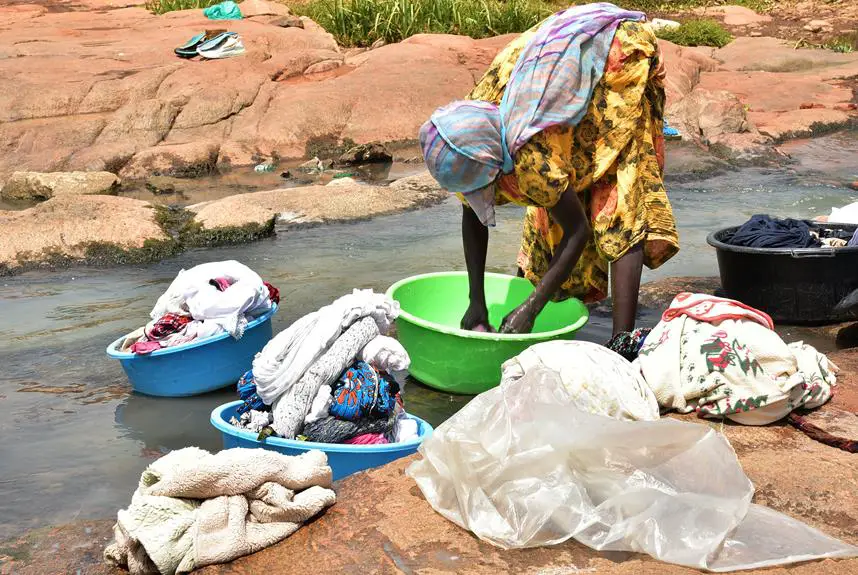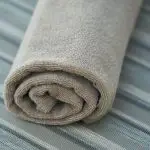Do you ever feel like laundry is a battleground, with your clothes caught in the crossfire?
When it comes to washing, using hot water may seem like the best way to ensure cleanliness. However, have you ever wondered if this practice is actually doing more harm than good to your fabrics?
Understanding the effects of hot water on different types of fabrics is crucial for maintaining their longevity and quality. In this exploration, we'll delve into the impact of hot water on fabrics, from color fading and shrinkage to environmental considerations.
By the end, you'll have the knowledge to make informed decisions about washing your clothes on hot without causing harm.
Key Takeaways
- Washing clothes on hot can lead to shrinkage, color fading, loss of shape, weakened fibers, and increased wear and tear.
- Hot water usage in laundry contributes to accelerated color fading, weakened fabric fibers, and long-term fabric degradation.
- The strength of fabrics decreases when washed in hot water, leading to color fading, fabric degradation, and loss of color vibrancy.
- Different fabric types react differently to hot water, with natural fibers like cotton and linen being more resistant while synthetic fibers like polyester and nylon are more susceptible to damage.
Effects of Hot Water on Fabrics
If you frequently wash your clothes in hot water, you may be causing damage to the fabrics. Fabric care is essential for maintaining the quality and longevity of your clothes. Water temperature plays a significant role in fabric care. Hot water can cause certain fabrics to shrink, fade, or lose their shape. The high temperature can also weaken the fibers, leading to faster wear and tear.
It's important to consider the fabric type when determining the appropriate water temperature for washing. Delicate fabrics such as silk, wool, and lace require cooler water to prevent damage. On the other hand, heavier fabrics like denim or towels can withstand warmer water but may still benefit from a cooler wash to preserve their integrity over time.
Understanding the impact of water temperature on different fabrics is crucial for effective fabric care. By following the recommended water temperature guidelines for various fabric types, you can ensure that your clothes remain in good condition for longer periods.
Color Fading and Fabric Degradation
When washing clothes in hot water, it's important to consider the potential impact on colorfastness and fabric strength.
Hot water can cause colors to fade more quickly, especially in fabrics that aren't colorfast.
Additionally, the high temperature may contribute to fabric degradation over time, affecting the overall lifespan of your clothing.
Hot Water Colorfastness
Washing clothes on hot water can cause color fading and fabric degradation due to the higher temperature accelerating the release of dyes and weakening the fabric fibers.
When considering hot water colorfastness, it's essential to understand its impact on color retention and fabric integrity. Here are key points to consider:
- Accelerated Color Fading: Hot water can lead to the accelerated release of dyes from fabrics, causing colors to fade more quickly than when washed in cooler temperatures.
- Weakened Fabric Fibers: The higher temperature can weaken the fabric fibers, leading to reduced fabric integrity and a shorter lifespan for the garment.
- Impact on Bright Colors: Bright and vibrant colors are particularly susceptible to color fading when exposed to hot water during the washing process.
- Long-Term Fabric Degradation: Repeated washing in hot water can contribute to long-term fabric degradation, affecting the overall quality and appearance of the garment.
Understanding these factors is crucial for maintaining the longevity of your clothing.
Fabric Strength Temperature
How significantly does the fabric strength diminish when washing clothes in hot water, and how does this impact color fading and fabric degradation?
Washing clothes in hot water can lead to a notable decrease in fabric strength, which can result in color fading and fabric degradation over time. High temperatures can cause the fabric fibers to weaken, making them more susceptible to damage and breakage.
This can lead to the loss of color vibrancy and structural integrity of the fabric. To maintain fabric strength and prevent color fading and degradation, it's crucial to adhere to fabric care and washing guidelines. Using cold or warm water for washing, as recommended for specific fabrics, can help preserve the strength and appearance of the fabric, ultimately prolonging the lifespan of your clothing.
Shrinkage and Fabric Distortion
When you wash clothes in hot water, you risk causing shrinkage and fabric distortion. High temperatures can lead to fibers contracting and fabrics losing their original shape.
Understanding the relationship between temperature and textiles is crucial in preventing these issues.
Hot Water Shrinkage
Using hot water in your laundry can lead to fabric shrinkage and distortion, affecting the fit and appearance of your clothing. To prevent hot water shrinkage and maintain the quality of your garments, consider the following:
- Cold Water Wash: Opt for cold water instead of hot when washing clothes, as it's gentler on fabrics and reduces the risk of shrinkage.
- Air Dry: After washing, air dry your garments instead of using a high heat dryer, as excessive heat can cause fabrics to shrink and distort.
- Read Care Labels: Always check the care labels on your clothing to determine the recommended water temperature for washing.
- Use Fabric Conditioner: Incorporate fabric conditioner into your laundry routine to help maintain the softness and flexibility of your garments, reducing the likelihood of shrinkage.
Following these fabric care techniques can help minimize the risk of hot water shrinkage and preserve the integrity of your clothing.
Fabric Distortion Risks
Have you noticed fabric distortion or shrinkage when washing your clothes in hot water?
Hot water poses the risk of fabric distortion, including shrinkage and stretching. To prevent these issues, consider taking precautions such as using cold water for delicate fabrics or those prone to shrinkage.
When using hot water, always check the care label instructions to ensure it's suitable for the specific fabric. Additionally, avoid overloading the washing machine, as crowding can lead to excessive friction and stretching of the fabric.
Selecting a gentle cycle and using a mild detergent can also help minimize the risk of distortion. By taking these preventative measures, you can maintain the integrity of your clothing and reduce the likelihood of fabric distortion when washing in hot water.
Temperature and Textiles
Washing clothes in hot water can cause shrinkage and fabric distortion in textiles. To prevent these issues, it's essential to understand the impact of temperature control on fabric care. Here's how water temperature affects laundry efficiency:
- Shrinkage: Hot water can cause natural fibers like cotton and wool to shrink, altering the garment's size and fit.
- Fabric Distortion: High temperatures may distort synthetic fabrics, leading to a change in texture and shape.
- Color Fading: Hot water can accelerate color fading in garments, especially with dark or bright colors.
- Energy Consumption: Using hot water increases energy consumption, impacting both the environment and your utility bills.
Impact on Different Fabric Types
How does washing clothes on hot affect different fabric types?
Fabric care and heat effects are crucial considerations when it comes to washing clothes on hot. Different fabric types react differently to hot water and can impact their longevity and appearance.
Natural fibers like cotton and linen can withstand hot water better than synthetic fibers such as polyester and nylon. Hot water can cause synthetic fibers to weaken, shrink, or lose their shape.
Delicate fabrics like silk and wool are particularly sensitive to heat and may become damaged if washed in hot water. Additionally, hot water can cause colors to fade, especially in vibrant or dark-colored fabrics.
Understanding the fabric care labels on your clothes is essential to determine the appropriate washing temperature for different fabric types. It's recommended to wash delicate fabrics in cold water to preserve their quality.
Environmental and Energy Considerations
Consider the environmental and energy impact of using hot water for laundry. When evaluating the use of hot water for laundry, it's important to consider its environmental and energy implications. Here are some key points to consider:
- Energy Efficiency: Heating water for laundry consumes a significant amount of energy. In fact, water heating can account for around 90% of the energy used by a washing machine. Using hot water unnecessarily contributes to higher energy consumption and increased greenhouse gas emissions.
- Environmental Impact: Hot water usage in laundry directly impacts the environment by increasing energy demand, leading to higher emissions of carbon dioxide and other pollutants. Conserving energy by using cold or warm water can significantly reduce the environmental impact of laundry practices.
- Cold Water Washing: Utilizing cold water for laundry can be equally effective in cleaning clothes while significantly reducing energy consumption. Advances in detergent technology also support the effectiveness of cold water washing in removing stains and odors.
- Sustainable Practices: Embracing cold water washing and optimizing energy efficiency not only reduces environmental impact but also contributes to sustainable living practices.
Tips for Washing Clothes on Hot Safely
When evaluating the use of hot water for laundry, it's important to ensure that your fabrics can withstand the higher temperatures to avoid potential damage. Taking precautions and using fabric care techniques can help you wash clothes on hot safely. Here are some tips to consider:
| Hot Water Precautions | Fabric Care Techniques |
|---|---|
| Separate by Color | Use a High-Quality Detergent |
| Check Fabric Labels | Pre-Treat Stains |
| Use the Correct Water Temperature | Follow Recommended Cycle Settings |
| Avoid Overloading the Washer | Properly Air Dry or Tumble Dry |
Separating clothes by color helps prevent color bleeding and fading. Checking fabric labels ensures that you are washing each item at the appropriate temperature. Using the correct water temperature is crucial; it's generally recommended to wash whites, towels, and bedding in hot water. Avoid overloading the washer to allow enough space for proper agitation and rinsing. Using a high-quality detergent and pre-treating stains can help maintain fabric integrity. Following recommended cycle settings and properly air drying or tumble drying can also contribute to washing clothes on hot safely while preserving fabric quality.
Conclusion and Recommendations
To maintain fabric quality, always follow care labels and use hot water sparingly when washing clothes. After considering the potential impact of hot water on fabrics, it's important to conclude with some practical recommendations for fabric care and safety precautions.
Conclusion and Recommendations
- Follow Care Labels: Always adhere to the care instructions on clothing labels to ensure you're using the appropriate water temperature and washing method for each garment. This simple step can significantly prolong the life of your clothes.
- Use Hot Water Sparingly: While hot water can be effective for certain items, such as heavily soiled or germ-laden fabrics, it should be used sparingly to avoid potential damage to the fabric fibers.
- Consider Alternatives: Explore alternative methods for disinfecting and cleaning clothes, such as using laundry additives, pre-soaking, or selecting a longer wash cycle with warm water instead of hot.
- Perform Regular Maintenance: Keep your washing machine in good working condition by running maintenance cycles and cleaning it regularly to prevent mineral buildup and ensure the proper functioning of temperature settings.
Frequently Asked Questions
Can Washing Clothes on Hot Water Help Remove Tough Stains Better Than Cold Water?
Washing clothes on hot water can help remove tough stains better than cold water. However, using hot water frequently may cause damage to some fabrics. It's important to consider both stain removal and fabric care when choosing the temperature.
Does Using Hot Water in the Washing Machine Increase the Likelihood of Clothes Shrinking, Even if They Are Labeled as Pre-Shrunk?
Using hot water in the washing machine can increase the likelihood of clothes shrinking, even if they are labeled as pre-shrunk. This can impact fabric durability and color preservation, potentially affecting the lifespan of your garments.
Are There Any Specific Fabrics That Should Never Be Washed in Hot Water, Regardless of the Laundry Instructions?
When washing specific fabrics, it's crucial to consider temperature sensitivity. Delicate materials like silk, wool, and spandex should never be washed in hot water, regardless of laundry instructions. Proper fabric care ensures longevity and maintains quality.
How Does Washing Clothes on Hot Water Impact the Environment in Terms of Energy Consumption and Water Usage?
Washing clothes on hot water impacts the environment by increasing energy consumption and water usage. Your consideration of energy efficiency and the environmental impact can guide you towards more sustainable laundry practices.
Are There Any Alternative Methods for Achieving the Benefits of Hot Water Washing Without Using as Much Energy?
To achieve energy-efficient washing, consider using cold water benefits. Alternative methods, like cold water detergents and pre-treating stains, can still provide effective cleaning. These tactics reduce energy consumption while maintaining laundry cleanliness.
- Tetron Fabric for Marine Applications: Durability and Use Cases - June 18, 2025
- Tetron Fabric for Outdoor Furniture: Weather Resistance and Care - June 18, 2025
- Tetron Fabric for Wall Coverings: Style and Application Tips - June 18, 2025






